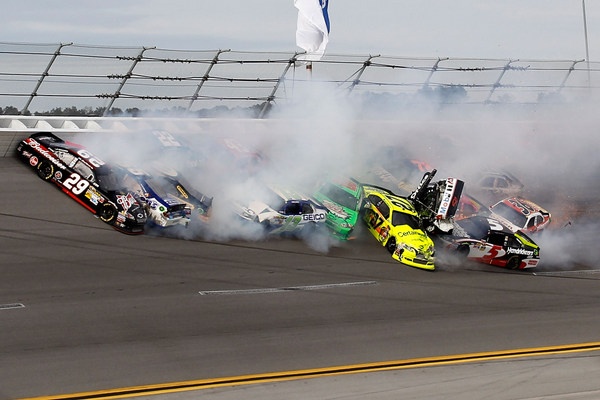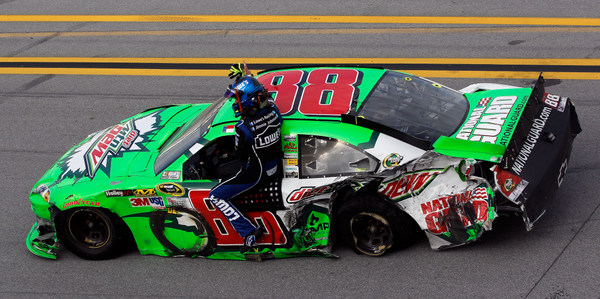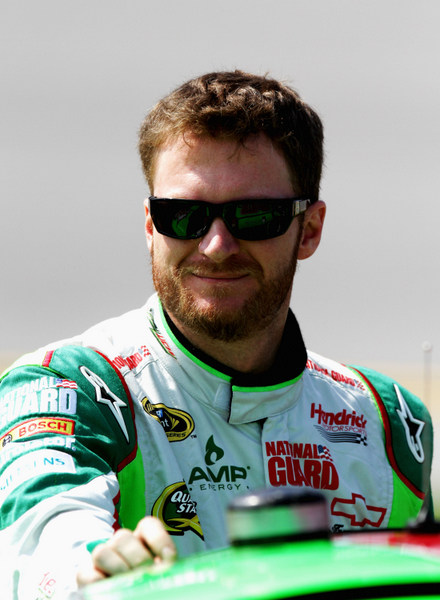More Breaking Now! The hot scoop Articles
Dale Earnhardt Jr., after two concussions over the past six weeks, will sit out Charlotte and Kansas City races, ending his championship bid

Dale Earnhardt Jr., in the green car, gets slammed in that 25-car crash Sunday at Talladega. But he says it was only a mild 20G hit. (Photo: Getty Images for NASCAR)
(Updated)
By Mike Mulhern
mikemulhern.net
CONCORD, N.C.
Dale Earnhardt, citing two concussions over the past six weeks, in crashes at Talladega and Kansas City, will be sidelined the next two weeks, in a major 'safety' twist for the sport, midway through the NASCAR championship playoffs.
The sport's most popular driver, though he passed medical examinations this week, in effect has taken himself out of the car for at least two weeks, after complaining about headaches.
The Earnhardt concussion issue may put yet another angle on some aspects of this sport:
-- Earnhardt Jr. called it "bloodthirsty" racing, after getting caught up in Sunday's crazy 25-car crash the final lap of the Talladega 500. Yet he says that hit only registered 20Gs, a relatively mild hit.
-- Earnhardt's blown right-front tire on Kansas Speedway's new asphalt five weeks ago, at about 205 mph, comes amid questions about cars perhaps racing too fast on these newly repaved tracks. He says that was a more severe 40G hit, and he says he felt uneasy after that crash.
This week, after feeling worried about the cumulative effects of those two hits, Earnhardt took it upon himself to get further medical examination.
The result:
Just four days after ripping current Talladega-Daytona restrictor plate rules for creating "dangerous" racing, Earnhardt has been scratched from Saturday night's 500 here at Charlotte Motor Speedway and from next weekend's NASCAR 400 at Kansas Speedway.
Regan Smith will be the team’s substitute driver at Charlotte and Kansas.
The stunning turn of events came at 8:30 a.m. ET Thursday, just as Charlotte Motor Speedway opened for business.
The Talladega crash was Earnhardt's second in recent weeks. He blew a right-front tire and hit the wall hard at Kansas during tire tests in early September. Earnhardt did not report any injuries from that crash. However head injuries can be cumulative.
That it was only after Earnhardt's own persistance in dealing with this week's headaches, and not any NASCAR safety policies or examinations, could be significant.
Earnhardt could have continued racing without any of his rivals or any sports officials understanding the full situation. In fact Earnhardt did just that himself in 2002 after a hard crash at California Speedway, not telling anyone for months about that issue.
The spectre of what happened to Neil Bonnett some 20 years ago hangs over this entire issue, despite the numerous safety improvements made in recent years.
Perhaps worriesome is that since Earnhardt drove his car back to the garage, he was not required to go to the infield care center for examination.
Also perhaps worriesome here is that if a driver, under NASCAR rules, sits out a race for whatever reason, his team gets no championship points for that race. NASCAR has no rule for 'medical' situations like that. Hence drivers and teams are naturally very reluctant to sit out a race.
Earnhardt, 51 points down, was thus all but out of the chase anyway; it is not clear if that had any bearing on Earnhardt's decision.

Dale Earnhardt Jr. giving teammate Jimmie Johnson a ride back to the Talladega garage after both were caught up in that last lap crash (Photo: Getty Images for NASCAR)
Earnhardt: "We had a test at Kansas about five weeks ago, and I remember everything about that accident, and after that accident. But you know your body and how your mind works, and I knew something wasn't right.
"I just tried to push through it. I felt pretty good after a week or two. I was 80 or 90 percent when the chase started. And at Talladega I felt 100 percent.
"I knew when something happened that I'd reinjured myself. It was not even half the impact I had at Kansas, but it was enough to cause me some concern.
"I spent a couple of days to see how my body would react. But by Wednesday I was still having some headaches. So I talked with my sister about seeing a neurosurgeon. Dr. Jerry Petty is a friend of mine. Met with him. Did an MRI, and everything looked good. But I was honest with him about how I felt, and Kansas, and he spent the night thinking about that. And he decided he couldn't clear me to race this weekend.
"When he says I need to take a couple of weeks off, that's what to do. I really didn't make the decision; I left that in the hands of the docs.
"'I didn't see anybody after Kansas. I regret that. I've had concussions before, and thought I knew what I was doing, just trying to do my job. I told Steve (Letarte, his crew chief) I felt pretty good
"When you have a concussion, symptoms can be mild, and then they go away after a couple of days. But until you get in the car at speed there is no way to know...
"I told Steve 'If we go to Atlanta and I don't feel good, we need to have a backup plan.'
"But I didn't know how it would go if I'd gotten medical attention and then had to get out of the car and then tried to get back in, with the chase starting.
"The shot at Kansas was only about 40Gs...and the accident at Talladega was only about 20Gs, not really that hard of a hit.
"I knew having those two concussions back to back was not good.
"I've had two concussions in the last four or five weeks, and you can't layer concussions."
Dr. Petty said Earnhardt's tests "were entirely normal," including an MRI. "That was very encouraging," Petty said.
"He had no amnesia on either side of the incidents, which is very important.
"What we will do now is give him four or five days of no headaches...and then we try to induce a headache, and then let him go out and drive. And if that's okay, then we'll let him drive again."
Petty said "90 percent" of concussions are in fact determined by the patient and his interactions.
That a driver himself is so key to the detemination of a concussion could be cause for alarm.
And it is unclear if Earnhardt -- or any other driver for that matter -- could simply medically clear himself to return to racing by just telling the doctors he now feels fine...since there are really no good tests for determining concussions.
Earnhardt noteably had a concussion at California Speedway in 2002, but didn't tell anyone for several months. That led NASCAR to reevaluate how it dealt with drivers and crashes.
Still, if a driver wants to hide a concussion, there appears little NASCAR or doctors can do to determine what the medical situation really is.
"The wreck at Kansas was really severe, and it surprised me, how hard it was," Earnhardt said.
Rivals at the Kansas test, though, say they knew right away that Earnhardt had taken a savage hit.
"At Talladega I started having headaches right after the wreck," Earnhardt went on. "Typically they only last 24 to 48 hours. And sometimes you don't even know you've had one."
Concussions haven't been a major issue in NASCAR for years, with the major safety improvements made in these cars and equipment. However Eric McClure was sidelined with a concussion after a Talladega crash in a spring Nationwide race.
The National Football League, on the other hand, has been in the headlines for months over the issue of concussions.
Apparently Earnhardt would have been okay to continue racing if he had not been so forthcoming during medical tests this week.
NASCAR apparently has no mandatory 'sit down' policy for drivers after a crash.
NASCAR apparently has no mandatory 'sit down' policy for drivers after a crash.
NASCAR's Steve O'Donnell said he was proud that Earnhardt was willing to step up and realize he had an issue and addressed it. "Our number one concern is Dale's health, and getting him back in a race car," O'Donnell said. "We will leave it up to Dr. Petty to determine when."
One problem with all this is that Earnhardt now realizes he had an issue after the Kansas crash yet he was cleared to continue racing.
O'Donnell says it's up to the drivers "to be upfront with us...and you saw that here today."
"We've only had nine concussions in our national series in five years...."
The 40G Kansas crash could have been an indicator to watch that driver more closely, O'Donnell concedes. "Knowing where we stand now, that will absolutely include that going forward."

Dale Earnhardt Jr. gets praise for conceding a second concussion and taking himself out of the game. However how does NASCAR respond to this situation? Concussions are dangerous, and sometimes difficult to diagnose. (Photo: Getty Images for NASCAR)
© 2010-2011 www.mikemulhern.net All rights reserved.
Web site by www.webdesigncarolinas.com







To race, or not to race
" Earnhardt, 51 points down, was thus all but out of the chase anyway; it is not clear if that had any bearing on Earnhardt's decision."
------------------------
I think that it did have bearing on the decision. If he was leading or within a few points of the lead, I think he would be in the driver's seat this weekend. He's out of it, so there's no need to go after it in the condition that he's in. It's a good call by Earnhardt Jr., but nobody is going to be believeable if they say he wouldn't be racing even if he was in the points lead.
Post new comment